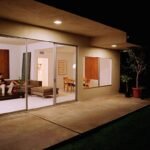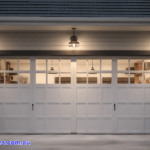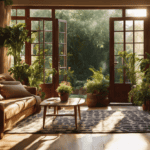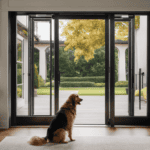Exploring French Doors
Introduction to French Doors
French doors have long been admired for their elegance and ability to enhance the beauty of a space. These doors, with their characteristic glass panels and intricate designs, bring a touch of sophistication to any architectural style. As a homeowner, it’s important to understand French doors’ historical significance and architectural impact when considering them for your home.
As we know them today, French doors trace their origin back to the Renaissance period in France. Italian architectural styles inspired these doors and were initially designed to allow more natural light into homes while providing a seamless transition between indoor and outdoor spaces. Over the centuries, French doors have evolved in both design and functionality, but their core characteristics have remained constant.
The Historical Significance of French Doors
French doors have had a profound influence on architecture throughout history. Their introduction revolutionized homes’ design, offering a new level of elegance and practicality. The concept of large, glass-panelled doors quickly spread across Europe, influencing various architectural styles.
During the 17th and 18th centuries, French doors became an integral part of European architecture. Notable examples can be found in France’s magnificent palaces and châteaux, such as the Palace of Versailles. These doors were often adorned with intricate carvings and featured multiple glass panels that allowed abundant natural light to flood the interiors.
French doors gained popularity in the United States during the late 18th century and early 19th century. The architectural style known as the Federal or Adam style embraced French doors, incorporating them into grand homes and public buildings. This trend continued through the Victorian era, with French doors becoming a staple in many American architectural designs.
By appreciating French doors’ origin and early designs and understanding their evolution over the centuries, homeowners can better appreciate their timeless beauty and architectural significance. To explore notable historical examples and learn more about the impact of French doors on modern design, visit our article on the impact of modern design.
French doors are a sought-after feature in contemporary homes, thanks to their timeless appeal and ability to create a seamless connection between indoor and outdoor spaces. In the following sections, we will delve deeper into the characteristics of French doors, their ability to maximize natural light and explore their modern applications for interior and exterior spaces.
French Doors in Architecture
French doors have significantly impacted architectural design, both in Europe and America. Let’s look at their influence and adoption in these regions.
Influence on European Architecture
French doors originated in France in the 17th century and quickly gained popularity throughout Europe. Their design, characterized by multiple glass panels, allowed for an increased flow of natural light and created a sense of openness in interior spaces. The earliest designs of French doors showcased intricate details and craftsmanship, adding an element of elegance to European architecture.
Over time, French doors evolved in style and design, adapting to the changing architectural trends. They became prominent in various architectural movements, including the Renaissance and Neoclassical periods. Notable examples of French doors in European architecture can be found in grand palaces, stately homes, and historic buildings. To learn more about French doors’ origin and early designs, you can visit our article on the origin and early designs.
Adoption in American Architecture
French doors made their way to America in the 18th century, thanks to the influence of European settlers. These doors quickly became a sought-after architectural element, particularly in residential construction. The adoption of French doors in American architecture was driven by their ability to seamlessly connect indoor and outdoor spaces, creating a sense of harmony and allowing easy access to gardens, patios, and balconies.
French doors were incorporated into various design movements as American architectural styles evolved, including Colonial Revival, Victorian, and Craftsman styles. They added a touch of elegance and sophistication to homes while also serving functional purposes. Notable historical examples of French doors in American architecture can be found in iconic buildings and historic landmarks. You can refer to our article on notable historical examples to explore some of these examples.
French doors continue to be a popular choice in modern architectural design. Their impact on European and American architecture is undeniable, and their versatility allows them to complement a wide range of architectural styles. To discover how French doors have influenced modern design, you can read our article on the impact of modern design.
The incorporation of French doors into architectural designs has enhanced the aesthetics of buildings and brought in abundant natural light. In the following sections, we will explore the characteristics of French doors and their ability to maximize natural light and create a connection with the outdoors.
Characteristics of French Doors
French doors have distinct design elements and features contributing to their timeless appeal. Let’s explore these characteristics and their versatility in different architectural styles.
Design Elements and Features
French doors are characterized by double-panel construction, where two doors are hinged on opposite sides and meet in the middle when closed. The doors are typically glass, allowing ample natural light to flow. The glass panels are often divided into smaller segments by mullions or grids, adding visual interest and architectural detail.
French doors often feature decorative elements such as intricate moulding, carvings, or etchings on the glass to enhance the aesthetic appeal. These embellishments can complement the overall architectural style of the space and add a touch of elegance.
Another notable feature of French doors is their ability to swing inward and outward. This dual functionality provides flexibility in terms of usage and can be particularly advantageous in spaces with limited room for door clearance.

Versatility in Different Architectural Styles
French doors have the unique ability to seamlessly blend with various architectural styles, from traditional to contemporary. Their timeless design and adaptability make them a popular choice for homeowners looking to add a touch of elegance and sophistication to their living spaces.
In traditional architectural styles such as Victorian or Georgian, French doors are often adorned with intricate detailing and large glass panels to create a sense of grandeur. The doors may feature decorative transoms or sidelights, enhancing their visual impact.
French doors with a simpler and sleeker design are commonly used in more contemporary settings. These doors often prioritize larger glass panels to maximize natural light and create a seamless connection between indoor and outdoor spaces. The minimalistic approach of contemporary French doors allows them to fit effortlessly into modern architectural styles.
French doors are also found in farmhouses and Mediterranean and colonial architectural styles. Their versatility lies in their ability to adapt to different design aesthetics while maintaining their classic charm.
By understanding French doors’ design elements and versatility, you can make informed decisions when incorporating them into your home. Whether you’re looking to capture the historical elegance of traditional architecture or embrace the sleekness of modern design, French doors can be a valuable addition to enhance your space’s overall aesthetic and functionality.
French Doors and Natural Light
French doors have long been recognized for enhancing natural light within a space. Let’s explore how these doors maximize natural light and create a strong connection with the outdoors.
Maximizing Natural Light
One of the defining features of French doors is their extensive use of glass panels. These doors typically consist of multiple glass panels, allowing abundant natural light to flood the room. The generous amount of glass brightens the space and creates an inviting and open atmosphere.
By incorporating French doors into your home, you can take advantage of the natural light available during the day, reducing the need for artificial lighting and creating a more energy-efficient environment. The increased natural light can positively impact your mood, productivity, and overall well-being.
Creating a Connection with the Outdoors
French doors serve as a seamless transition between the interior and exterior of a home, creating a strong connection with the outdoor spaces. The extensive use of glass in French doors allows homeowners to enjoy unobstructed views of their surroundings, whether a beautiful garden, a picturesque landscape, or a serene backyard.
Beyond providing a visual connection, French doors also enhance the physical connection to outdoor areas. They provide easy access to patios, decks, or gardens, allowing homeowners to move between indoor and outdoor spaces seamlessly. This connection to nature can enhance the overall living experience and create a more harmonious relationship between the interior and exterior of the home.
By incorporating French doors into your home, you can maximize the amount of natural light and create a stronger connection with the outdoors. These doors serve as a gateway to the beauty of nature, allowing you to bring the outside in and enjoy the benefits of natural light throughout your living spaces. For more information on the impact of French doors on modern design, check out our article on modern design.
Modern Applications of French Doors
French doors are popular in modern architecture for their aesthetic appeal and practical functionality. They are commonly used in interior and exterior applications, adding charm and sophistication to various spaces.
Interior French Doors
Interior French doors are a stylish addition to any home. They often create separation between rooms while maintaining an open and airy feel. These doors feature glass panels that allow natural light to flow through, enhancing the brightness and spaciousness of the interior.
In addition to their visual appeal, interior French doors provide the flexibility to create versatile living spaces. They can divide a living room and dining room, create a private home office, or even separate a master bedroom and ensuite bathroom. The glass panels connect spaces visually, making the layout cohesive and open.
When choosing interior French doors, consider the design elements that complement your interior decor. Whether you prefer traditional or contemporary styles, various options are available to suit your taste and needs. Installing interior French doors can transform the ambience of your home, adding a touch of elegance and sophistication.
Exterior French Doors
Exterior French doors are popular for homeowners who want to blend their indoor and outdoor living spaces seamlessly. These doors create a smooth transition between the home’s interior and the patio, garden, or backyard. They are often used as access points to outdoor entertainment areas, providing a picturesque view and allowing for easy movement between the inside and outside.
One of the key benefits of exterior French doors is the abundant natural light they bring into the home. The large glass panels allow sunlight to filter in, brightening the interior and creating a warm and inviting atmosphere. Additionally, the glass panels provide unobstructed views of the outdoor scenery, allowing you to enjoy the beauty of your surroundings from the comfort of your home.
Exterior French doors come in various materials and styles, allowing you to choose the option that best suits your home’s architectural design. Whether you prefer the classic elegance of wooden frames or the sleek and modern look of aluminium, a wide range of choices are available. Consider factors such as energy efficiency, security features, and maintenance requirements when selecting exterior French doors for your home.
You can create a visually stunning and functional space by incorporating interior and exterior French doors into your home design. French doors’ timeless appeal and versatility make them popular among homeowners looking to elevate their interior and exterior aesthetics. Explore different styles and materials to find the perfect French doors that align with your design preferences and enhance the overall appeal of your home.

What Are the Historical Roots of French Doors and Their Impact on Modern Architecture?
The impact of French doors on modern architecture is undeniable. Originating in 17th century France, these double doors with glass panels were a symbol of luxury and elegance. Their incorporation into buildings allowed for better natural light and a seamless connection between indoor and outdoor spaces, shaping architectural design for centuries.
Enhancing Your Home with French Doors
French doors have a timeless appeal and can significantly enhance the aesthetic and functionality of your home. When considering the addition of French doors, it’s important to choose the right style and carefully consider installation and maintenance. Let’s explore these aspects in more detail.
Choosing the Right Style
Selecting the right style of French doors is vital to ensure they complement your home’s architecture and reflect your taste. Various styles are available, including traditional, contemporary, and modern designs. Consider the following factors when making your choice:
- Material: French doors can be constructed from different materials, such as wood, fibreglass, and steel. Each material offers its unique benefits in terms of durability, insulation, and aesthetics. Choose a material that aligns with your preferences and fits well with the overall look of your home.
- Glass Options: French doors often feature glass panes, contributing to their elegance and allowing natural light to flow into your space. Depending on your desired level of privacy and style, you can choose from different glass options, including clear, frosted, or textured glass.
- Hardware and Finishes: Pay attention to the hardware and finishes of the French doors. These small details can significantly impact the overall look and feel. Opt for finishes that complement the existing fixtures in your home, such as doorknobs, hinges, and handles.
To explore French doors’ history, origin, and early designs, check out our article on origin and early designs. Additionally, for a closer look at how French doors have evolved over the centuries and their impact on modern design, refer to our article on the impact on modern design.
Considerations for Installation and Maintenance
Installing French doors requires careful planning and attention to detail. Hiring a professional contractor or carpenter is advisable to ensure proper installation. They can help with measurements, structural considerations, and modifications to accommodate the doors.
Maintenance of French doors is relatively straightforward but essential for longevity and performance. Here are some considerations:
- Cleaning: Regularly clean the doors inside and outside using a mild detergent and a soft cloth. Avoid abrasive cleaners or materials that could scratch the glass or damage the finish.
- Door Hardware: Periodically check and tighten loose hardware, such as screws and hinges. Lubricate moving parts, such as hinges and locks, to ensure smooth operation.
- Weatherstripping: Check the weatherstripping around the doors for signs of wear and tear. Replace any damaged or worn weatherstripping to maintain energy efficiency and prevent drafts.
- Painting and Finishing: If you have wooden French doors, monitor the condition of the paint or finish. Touch up any areas showing peeling, cracking, or fading. This helps protect the wood from moisture and prolongs its lifespan.
For notable historical examples of French doors and their impact on architecture, visit our article on notable historical examples.
By choosing the right style and considering installation and maintenance factors, you can enjoy the beauty and functionality of French doors in your home for years to come.

I’m James Davis, a carpenter with eight years of experience in carpentry services, repairs, installations, renovations, and maintenance of interior doors. I have a diploma in carpentry and joiner trade from the Education Skills Australia Institute and take pride in delivering high-quality results to ensure customer satisfaction. I’m a blog writer for Octopus Doors Company and enjoy sharing my knowledge and tips on maintaining security measures and choosing the right door materials, paints, or handle styles. I specialize in custom-made interior doors and strive to make every home look fabulous. Contact me anytime for help with door-related issues.











